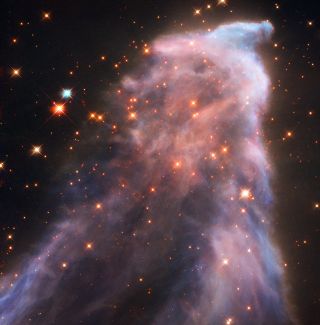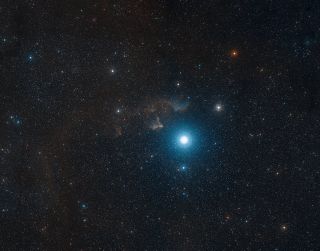The 'Ghost of Cassiopeia' Drifts Along in This Spooky Hubble Image
The "Ghost of Cassiopeia," a slowly eroding cloud of gas and dust, forms a glimmering haze in this eerie image from the Hubble Space Telescope.
The nebula, called IC 63, drifts 550 light-years from Earth in the constellation Cassiopeia. Its ethereal shape is influenced from afar by the fiercely shining variable star called Gamma Cassiopeiae. Though the star is several light-years from the nebula, it makes its powerful presence felt with blasts of radiation, according to a statement from the European Space Agency.

The blue-white subgiant star has 19 times the sun's mass and can reach 65,000 times the sun's brightness as it rotates at 1 million miles (1.6 million kilometers) per hour, which is more than 200 times the speed of the sun's rotation, according to the statement. It's surrounded by a disk of material that periodically blasts with material during its furious spin, making the star temporarily blaze brighter in the northern night sky.
Gamma Cassiopeiae contributes in two different ways to the nebula's creepy color palette. First, ultraviolet radiation from the star makes its way to the nebula, energizing its hydrogen molecules and prompting them to release a deep-red glow of hydrogen-alpha light. And second, light from the star reflects off the nebula's dust, glowing a cool blue.

Looking from Earth, the entire region of nebulas under Gamma Cassiopeiae's influence can be seen in autumn and winter from the Northern Hemisphere, but the area is very dim, and IC 63 is just a small part of it. This view from Hubble, looking from above Earth's atmosphere, gives "possibly the most detailed image that has ever been taken of IC 63," ESA officials said in the statement.
And the ultraviolet light that contributes to the nebula's ghostly glow will be its undoing, too — the radiation is slowly dissipating the nebula from light-years away, according to the statement.
Someday, there may be nothing left at all.
Get the Space.com Newsletter
Breaking space news, the latest updates on rocket launches, skywatching events and more!
Email Sarah Lewin at slewin@space.com or follow her @SarahExplains. Follow us on Twitter @Spacedotcom and on Facebook. Original article on Space.com.
Join our Space Forums to keep talking space on the latest missions, night sky and more! And if you have a news tip, correction or comment, let us know at: community@space.com.

Sarah Lewin started writing for Space.com in June of 2015 as a Staff Writer and became Associate Editor in 2019 . Her work has been featured by Scientific American, IEEE Spectrum, Quanta Magazine, Wired, The Scientist, Science Friday and WGBH's Inside NOVA. Sarah has an MA from NYU's Science, Health and Environmental Reporting Program and an AB in mathematics from Brown University. When not writing, reading or thinking about space, Sarah enjoys musical theatre and mathematical papercraft. She is currently Assistant News Editor at Scientific American. You can follow her on Twitter @SarahExplains.
